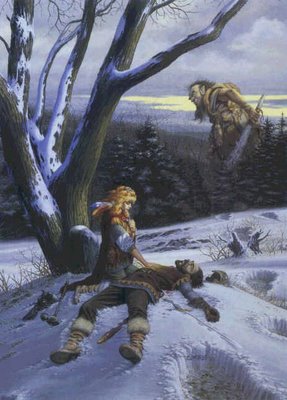 Every five years, when the three moons of Celni, Ilshora, and Navi align on the longest day of the year and block out the sun's mighty sphere there comes a time that the people of the Valley call Blood Moon.
Every five years, when the three moons of Celni, Ilshora, and Navi align on the longest day of the year and block out the sun's mighty sphere there comes a time that the people of the Valley call Blood Moon.
Blood Moon is a time of fear in the valley where there are no tall walls or city guards to keep the common folk safe. What's more, there is no evidence that the other parts of the world are afflicted by the events that ensue during Blood Moon. So the people of the valley have consigned themselves to enduring it alone.
When the moon goes bloody the valley folk hold up in their homes or in common buildings such as inns, shops, etc.. They do not venture out and it is the duty of every member of a community to prepare for the coming of Blood Moon on his or her own. Though sharing is never a problem except in extreme circumstances, it is still thought of as bad form to not at least make an effort to try and supply oneself for the duraton of the dark passing.
What the people are hiding from is the opening of the very netherworld. Blood Moon brings forth the host of the dark places. The woodlands creep with Witch Wood and the streets moan with living shadows. Travellers unfortunate enough to be caught on the road during this dark time are harried by all manner of manifestations, but none are more feared than the Garl.
The Garl are the unquestioned masters of Blood Moon, flying throug hthe skies, casting their dark shadows across the bloody sphere of the eclipsed sun. The Garl swoop and cry, screaming and haunting the people of the valley. Those they catch, they carry away or rend where they are found. Those so rent are doomed to walk the nights as spectres and haunts, their spirits bound to the place of their death for all eternity. Blood Moon is truely a dire time.
If not for the powerful energies that flow through the valley during this time, no sane man would brave venturing forth during Blood Moon. There are those that do, however, seeking to unlock the secrets of the dark passage of the eclipse. Legends abound about Blood Moon's thinning of the veils between plains and increase in magical energies during the time. There are also legendary placeswhich can only be reached during the time.
Blood Moon is not known by just men, however, and the other races of the valley also mark its passing. To the elves it was known as Kagonost and the dwarven observers of this time know it as Gurok. To the Unmen of the valley it is seen as a holy time when their ilk are given a time to rise and reap the valley for its spoils. They call it by many tribal names but nearly every clan and tribe has some name for it. The Thanes of the western peaks know it as Hemhost and mark is as the day when a great giant swallows the sun and they can see his face leering in mockery at them from the face of the prominant moon.
 Widders are a strange sort of psuedo priest and hedge wizard combined, though no Widder would ever concede to such an identity. More so the Widders of veil see themselves as simple wisemen and women, possessed of an acumulated knowledge based on common sense and a straight forward view of the world around them.
Widders are a strange sort of psuedo priest and hedge wizard combined, though no Widder would ever concede to such an identity. More so the Widders of veil see themselves as simple wisemen and women, possessed of an acumulated knowledge based on common sense and a straight forward view of the world around them.





